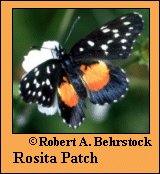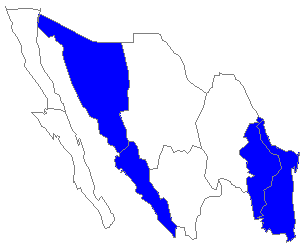 |
 

 |



Rosita Patch (Chlosyne rosita Hall)
Wing span: 1 7/16 - 1 11/16 inches (3.7 - 5 cm).
Identification: Both surfaces of forewing are black with white spots. Upperside of hindwing is black; basal patch is red-orange with yellow at the base.
Life history: Eggs are laid on the underside of host plant leaves.
Flight: Many flights, throughout most of the year, in South Texas.
Caterpillar hosts: Several plants in the acanthus family.
Adult food: Flower nectar.
Habitat: Subtropical forest openings.
Range: El Salvador north to Mexico. Periodic colonist in the lower Rio Grande Valley of South Texas; rare stray to northern Texas and southeastern Arizona.
Conservation: Not usually required.
The Nature Conservancy Global Rank: G4 - Apparently secure globally, though it might be quite rare in parts of its range, especially at the periphery.
Management needs: Provide host plant patches in refuges and parks along the lower Rio Grande Valley, Texas.
References:
Opler, P. A. and V. Malikul. 1992. A field guide to eastern butterflies. Peterson
field guide #4. Houghton-Mifflin Co., Boston. 396 pages, 48 color plates.
Scott, J. A. 1986. The butterflies of North America. Stanford University Press,
Stanford, Calif. 583 pages, 64 color plates.
Author: Jane M. Struttmann
State and Regional References:
Opler, Paul A. 1999. Peterson Field Guide to Western Butterflies, revised
edition. Houghton Mifflin Co., Boston, Mass.
Stanford, R.E. and P.A. Opler. 1993. Atlas of Western USA Butterflies.
Privately published, Denver, Colo.

